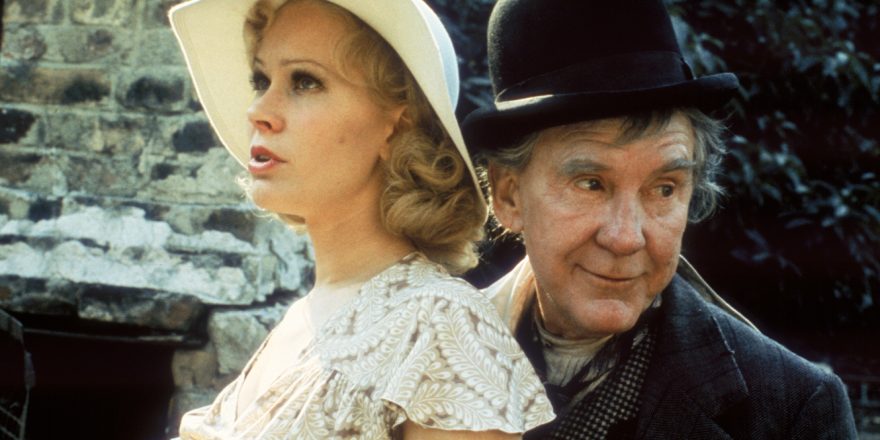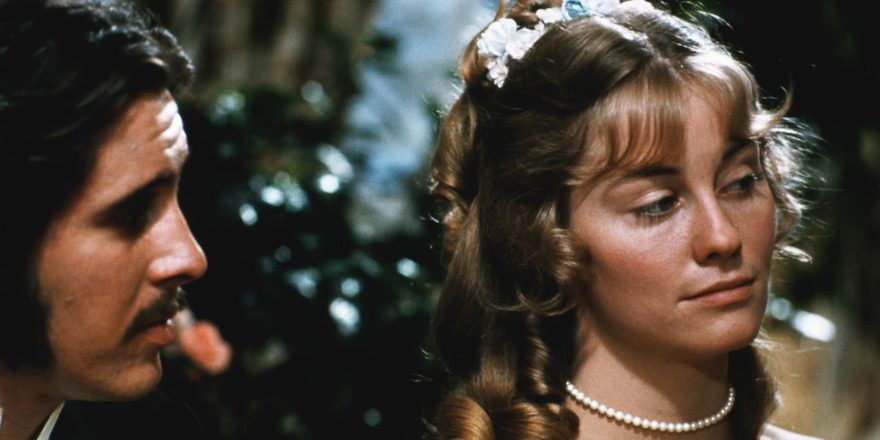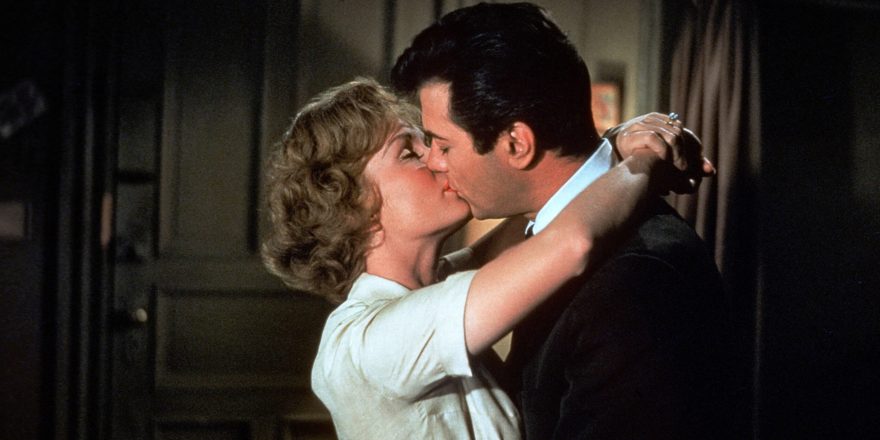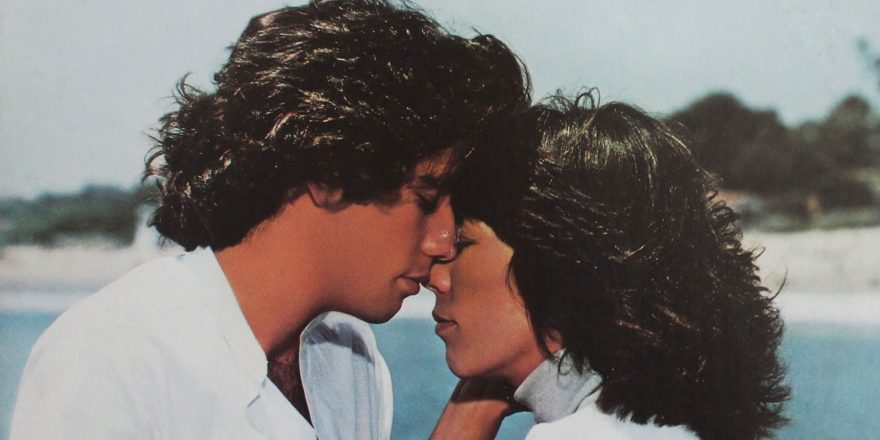It’s not as if The Day of the Locust was a complete bomb upon its release in 1975. The reviews were decidedly mixed, and it made a modest amount of money at the box office. But for the highly anticipated reunion of screenwriter Waldo Salt and director John Schlesinger, a duo that had hit the mother lode with Midnight Cowboy in 1969, the film, and both men, taking home Oscars, it was perceived as somewhat of a disappointment. Never mind that the task of adapting Nathanael West’s surrealistic, nightmarish novel to the silver screen was a near impossibility, and that its caustic, merciless disembowelment of Hollywood practically predestined the movie version to be reviled and disdained in the U.S.A., particularly as it was directed not only by an Englishman, but also by a homosexual (if indeed Americans bothered to make a distinction between the two). Critics of the film have been kinder retrospectively, but it seems to me that it could arguably now be regarded as one of the best films of the seventies, and Karen Black’s performance, one of the most grossly overlooked.
The brilliance of Salt’s adaptation of West’s novel lies partly in the fact that he actually brings some humanity to its Heart of Darkness take on Hollywood, abetted by Black’s heartbreaking, incandescent performance (Salt and Black were quite close, and he reputedly incorporated some of her ideas about her character, Faye Greener, into the script), and partly in his fearlessness in taking the most unpalatable, hideous aspects of the novel even further than West did. A prime example of this is the acknowledgment of an overt and casual racism in Hollywood of the era (which clearly persists today), outside of the obvious significations of buffoonish black servants, blackface and novelty tap dancers. In the novel, Harry Greener, Faye’s tragic vaudevillian and bit-player father, is known for the infamous line, “To hell with that bastard: I knew him when he cleaned spittoons in a nigger barroom.” (The “N-word” is used only once in the book.) Not only is the line preserved in the screenplay (scathingly delivered by Burgess Meredith, in a bilious, tour de force performance), but several other equally odious, racist lines are also invented by Salt for other characters. When Abe Kusich, played by legendary character actor and little person Billy Barty, is asked to tone down his language, he replies, “Who am I, a nigger?” Later, Black’s Faye says to the schlubby Homer Simpson (played by Donald Sutherland – and yes, the name of The Simpsons character came from the novel), “Only a nigger could wear an outfit like that.” The repetition of the “N-word” suggests how deeply racist attitudes were embedded in the very language of Hollywood culture, and to have one of the lead characters of the film deliver such a line makes that point emphatically at the risk of jeopardizing any sympathetic identification with her. Clearly, the filmmakers are not interested in whitewashing Hollywood in any way, as is often the practice even today, La La Land being only one of the most egregious examples.
The many divergences and inventions of the film may have been necessary to fill out the spare economy of the novel (more accurately a novella), but the genius of the filmmakers is that they had the audacity to turn such a slender volume into an epic. The Day of the Locust is both a glossy, gauzy simulacrum of a classic Hollywood movie product – beautiful camera work (by Conrad Hall), elaborate sets, and ambitious sequences in both scale and scope – and a corrosive deconstruction of the mechanics behind such products, an ambivalence in which the film revels. The deconstruction is even at times literal, as with the large-scale filming of the Battle of Waterloo sequence, which becomes a proto-apocalyptic nightmare when the set, designed by ambitious art director Tod Hackett (William Atherton), caves in on itself, leaving both cast and crew maimed and bleeding. Whereas the novel is more florid and poetic in its rendering of such sequences, using intricately descriptive language to evoke the very fabric of the images and their ironic inscription, the film is more concerned with the overblown Hollywood spectacle itself, the limitless erection and dismantling of sets of mind-boggling proportions. As a writer, West builds grotesque, absurd castles in the sky; as a director, Schlesinger moves into them.
The film starts out with a beautiful image not found in the book, of Faye Greener painting her toenails in the gleaming Los Angeles sunlight, diffused by one of the ubiquitous sprinklers that are always in the foreground in the sun-parched city, as Satchmo sings
“Jeepers Creepers,” the creepy musical theme of both book and film, on the soundtrack. Tod Hackett is shown an apartment at the same residence where the Greeners live, the San Bernardino Arms (a three-story building in the novel, the film cleverly adapts it to a single-story courtyard apartment to enhance the social relations of the characters), a room that has, as its main feature, a crack in the wall created by an earthquake. (The landlady tells him she calls it “our earthquake cottage”; later Tod refers to the décor of his building as “early earthquake.”) Tod moves in immediately, mostly owing to the presence of the beautiful Faye Greener. He refuses to fill the crack in his wall, and puts a rose in it instead, thus creating the central metaphor of the film (again, not in the novel), beauty and apocalypse rolled into one.
The movie introduces Hollywood with a couple of set pieces that are not in the novel as Tod takes Faye on a tour of celebrity homes and to the Hollywood sign. The tour guide tells the story of a starlet who threw herself off the H in Hollywood (an obvious reference to the tragic true-life tale of Peg Entwistle), and other stories about “this imposing erection.” (Both film and book are filled with tropes of erections and impotence, hard cocks and soft cocks, culminating in the harrowing cockfight scene.) After Faye takes Tod, along with Earle Shoop (Bo Hopkins), the cowboy from central casting, to a movie in which she has a bit part, they walk through an outdoor ping pong club (genius set) as Tod tries to ditch the country rube, who is also trying to bed Faye. The story is essentially one of the unrequited love, or more accurately, lust, that Tod has for Faye, who tells him, “I could only let a rich man love me, someone criminally handsome. Please try to understand.”
Black’s performance is remarkably layered and complex. At the height of her own Hollywood fame, she is playing an aspiring Hollywood star with deep, supercilious affectations who acts out her life as if she were always in a movie. Black is almost 20 years older than the character as written in the novel, who is 17, and yet she convincingly embodies the youthful naivety and vivacity of Faye Greener. The seventies allowed some of its female stars to look far more eccentric than today’s – think Shelley Duvall, Sissy Spacek or Barbra Streisand – and Black, with her close-set eyes and strong features, had a beauty that harkened back to the Golden Age of Hollywood. (The year before Locust, she made an indelible impression as Myrtle in Jack Clayton’s adaptation of The Great Gatsby, another big-budget Hollywood spectacle directed by an Englishman.) Black talked in interviews about how she wanted to bring a certain sympathetic quality to Faye, which I would venture to call a feminist strategy. She holds her own not only in a male-dominated story, but in the production as well. I once had the enormous privilege and pleasure to interview Ms. Black on stage after her heartfelt and personal one-woman show at the Gladstone Hotel in Toronto in 2009, just four years before her premature death from cancer at the age of 74, and I quickly learned that there were two things she was loathe to talk about: her “scream queen” image, and her experience making The Day of the Locust, which she claimed ruined her career in Hollywood. She told me that Schlesinger and Sutherland ended up excluding her from their boy’s club, which makes the fact that she all but steals the movie all the more impressive. Sadly, she said, owing to her “reputation” on the film, she began to be passed over for bigger roles; she went on, however, to become one of the most prolific indie actresses in the business right up until her death in 2013. It should be noted that her performance in Altman’s 1982 Come Back to the Five and Dime, Jimmy Dean, Jimmy Dean, in which she played a transsexual character, rates with the best of her career. (She also claimed that Oscar winners Sandy Dennis and Cher snubbed her on the set of that movie because she’d never won one, but that’s another story!)
Tod gets a job designing the set for the Napoleon movie, introducing his drawings as a key element of the film, including those of “the people who go to California to die” and his visions of “The Burning of Los Angeles.” Faye Greener ends up meeting Homer Simpson when her father has a near stroke at Simpson’s home while trying to sell him his door-to-door miracle products, and later, after Harry’s death, Faye moves in with Homer, much to the chagrin of Tod. Homer, however, is sexually repressed and doesn’t want to have sex with Faye, which suits her fine, as she soon invites Earle Shoop, the cowboy, and his Mexican friend, Miguel (Pepe Serna), to move into Homer’s garage. This is where the grotesque cockfight will transpire, a liquor-ridden night that ends up with Faye bedding the Mexican, and ultimately leaving Homer.
The plot of The Day of the Locust is not terribly complicated, but the many elaborate set-pieces and sequences make the film seem rich and dense. Even the simple sequence of Homer sitting alone and morose in his backyard, or Faye sitting in front of her triple mirror fussing with a pimple while singing “Jeepers Creepers,” oblivious to her father dying in the background, become minor epics of visual and sound details in themselves. Salt and Schlesinger recognize that the devil is in the details of West’s novel, the descriptive passages packed with references to color, shape and texture, so scene after scene the movie dazzles us with such details. (The brilliant production design of the film is by Richard MacDonald; he also worked on Schlesinger’s Far From the Madding Crowd and Marathon Man.)
Finally what makes Schlesinger’s adaptation of The Day of the Locust unique is his “queering” of the original. Schlesinger casts child star Jackie Earle Haley (who would appear the following year in The Bad News Bears) as Adore, written as a male child actor in the novel. Putting him in drag for the role of the monstrous little mutation of Shirley Temple adds a perverse and exploitative edge to an already perverse character, the child constantly abused by her belligerent stage mother. After the Waterloo sequence, Faye takes Tod and Homer to a swank nightclub where a drag queen (Paul Jabara, legendary songwriter for Donna Summer) performs Marlene Dietrich’s “Hot Voodoo” number from Blonde Venus, a layered allusion to the obvious repressed homosexuality of both of her companions, a suggestion that is only latent in the novel. In the incredible scene in which Faye and the Mexican lasciviously bite into lemon wedges and sling back tequila, a jealous Tod comes close to raping Faye, but he is too drunk. The movie takes the scene further than the novel, underlining Tod’s impotence. (In Looking for Mr. Goodbar, made two years later, William Atherton plays a similarly repressed and impotent character that tries to force himself on Diane Keaton but can’t perform, which causes her to suggest he’s a gay.) Homer’s homosexual panic, and his suggested sexual attraction to Tod, is made more overt in the movie, to the point where it almost seems as if the two of them are more interested in each other than in Faye. And as we all know, homosexual panic is always a strong subtext in the best horror films.
The famous finale of The Day of the Locust, in which the glamorous premier of the Cecil B. DeMille movie The Buccaneer turns into an apocalyptic orgy of carnal violence and carnage, transforms the work into a true horror film. Adore torments Homer, calling him a Nazi spy, until he loses his temper and ends up brutally stomping her to death, his repression erupting in a monstrous form. (Sutherland does not play well with children – he memorably mangles and kills a child by banging him against the walls of a room in a fit of rage in Bertolucci’s 1900.) When the peanut-crunching crowd, already manically hopped up on celebrity and glamour, turns on Homer, it literally tears him to pieces like a pack of cannibals before looting the city and setting in on fire. As Tod tries to save Homer, distraught more like a lover than a friend, his drawings of the people who go to California to die come to life in a Goya-esque sequence that truly makes your skin crawl, an ingenious montage that qualifies as a work of art in itself, amplified by the magnificent, discordant John Barry score. His mouth contorted open in a shape reminiscent of Munch’s The Scream, Tod crawls to the curb a broken and mangled man. A brief coda in which he returns to the San Bernardino Arms, also not in the novel, ends the film on a note of pathos, a quality of which West’s work is mercilessly bereft.






